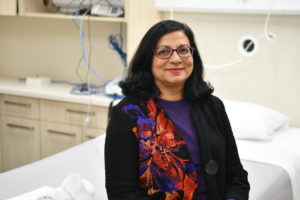As the female co-chair of the Taskforce Guidelines Leadership Group, the contribution of Associate Professor Sutapa Mukherjee in the fight against COVID-19 is reason enough to be recognised on International Women’s Day, but the story of her path to get to this position is worthy of telling any time.
Sutapa, a respiratory and sleep medicine specialist, outlines her early life and medical career speaking by Zoom from her home in Adelaide. She has spoken about medical matters via video conference at regular intervals since the world was upended by the rapid spread of COVID-19.

Thankfully, Sutapa has unknowingly been preparing for this her whole life with a medical and academic upbringing and a global perspective.
In the mid-1960s, Sutapa’s parents were living in their native India when they decided to emigrate. Her father, Tapen Mukherjee, was a doctor who was delivering many babies without being paid much, because the families were unable to afford it. Her mother, Karobi, was an academic sociologist. When Tapen saw an ad in The Lancet, the prestigious medical journal, which described an opportunity to undertake an MD in pathology at the University of Otago in Dunedin, in the south of New Zealand, he sat down in his local library and wrote an application. To his surprise, he later received a telegram advising of his success. Karobi was heavily pregnant with their first child when the couple arrived in Dunedin midway through 1965. Sutapa was born soon afterwards. Three years later, another girl, Sinjini, was born.
In that era, Australia’s immigration policy retained hallmarks of the white Australia policy. To be an immigrant from outside Europe, you had to be a professional in a highly valued field. In effect, you had to be a doctor, lawyer or engineer. In 1969, Tapen and Karobi Mukherjee moved their young family to Adelaide after Tapen was appointed as the head of electron microscopy at the city’s Institute of Medical and Veterinary Science. The family settled in St Georges, in Adelaide’s eastern suburbs.
Sutapa says her parents were mindful of raising their children as Australians who had an Indian background, rather than Indians who happened to be living in Australia. The Mukherjee parents did not force their girls to learn Bengali, which was the dialect they had spoken in India. The family knew every member of Adelaide’s small Indian community, most of whom were doctors, lawyers or engineers, but they enjoyed mixing in wider social circles, with academics, musicians, sportspeople (especially cricketers) regular visitors to the Mukherjee home. Sir Don Bradman and his wife Jessie were close family friends and visited regularly for dinner.
Karobi settled into a role as a sociology lecturer at the University of South Australia. Her topics of interest included sociology and women’s studies. Discussions around the family dinner table were lively.
‘It was an environment in which everyone could have their views,’ Sutapa says. ‘My parents were pioneers in many ways.’
Sutapa says she wanted to be a doctor from as young as eleven or twelve years of age. She could see the joy it gave her father as well as the opportunity to help people. Her parents encouraged her ambition but said she could do whatever she wanted. ‘But, they added, you must be better than everyone else,’ Sutapa says. ‘Because you’re different.’
Despite embracing many Australian customs their appearance set them apart. Sutapa and her sister attended primary school only 250 metres from the family’s front gate. She was regularly subjected to disturbing racism such as a boy who chanted “blacky, blacky, blacky” while walking home from school.
While the hurt does stay with her, it didn’t stop her ambition and fuelled both her tenacity and desire to reach her full potential.
In Year 7, Sutapa earned a scholarship to a local private school, Seymour College where she was embraced without condition by her fellow students – many of whom are still good friends today. Sutapa thrived and was accepted into medicine at the University of Adelaide.
After graduating with a medical degree, she undertook specialist physician training in respiratory medicine. In the final year of her specialist training, Sutapa moved to Perth where she completed her training. She then undertook postgraduate study at the University of Western Australia, investigating gene therapy of lung cancer. Sutapa was awarded a PhD in 2001. When her husband, Lyle Palmer, commenced postdoctoral work at Harvard University in Boston, Sutapa was invited to study occupational epidemiology by researching possible causes of cancer in industrial workplaces. She looked at the effects of diesel fumes on bus mechanics and boilermakers who toiled in coal-fired boilers.
When they returned to Perth, Sutapa resumed her broadening interests in respiratory matters. She enjoyed practising medicine as well as continuing her role in research. She became immersed in studies in the growing field of sleep health and sleep medicine. She led the establishment of a landmark study that monitored the sleep of 5,000 patients in Western Australia (The Western Australian Sleep Health Study).
In 2011, Sutapa moved to Canada, where she was an assistant professor at the University of Toronto and a respiratory and sleep physician at Women’s College Hospital (Toronto’s first medical school and hospital set up in 1883 to train female doctors after other medical schools refused to accept them). Many health workers in Toronto had been affected when the virus that was called severe acute respiratory syndrome, better known as SARS, spread to various parts of the world in 2003. Sutapa learnt much from her colleagues about the protocols that had been established to curb the spread of SARS during its Canadian incursion.
While in Toronto, she retained a leading role in the sleep study she had helped to set up in Western Australia. Her larger role, however, was developing and supervising an international study in population health, including sleep health (The Ontario Health study) that included over 230,000 adult volunteers. In 2014, she was invited to chair the American Thoracic Society’s Committee on Healthy Sleep.

But when the pandemic began Sutapa found herself in a similar predicament to other medical experts – it’s difficult to advise with certainty on an unknown disease with no specific evidence. She fielded a stream of requests on diagnosis and treatment guidelines and consulted colleagues in Perth, Melbourne, Boston and beyond. Her colleagues in Toronto were especially helpful on matters of protocol, given their experience in facing down the threat of SARS.
In late March 2020, Sutapa was invited to represent the Australasian Sleep Association at the newly established Taskforce and the Guidelines Leadership Group. Australia’s peak health bodies were scrambling to provide guidance to their members but now the Taskforce could reduce this duplicate effort and provide one trusted single voice of truth on how to best care for people with COVID-19 across primary, acute and critical care settings.
The GLG includes more than 30 of Australia’s leading clinical experts who volunteer their time each week on top of their own demanding schedules. This exceptional group of multi-disciplinary clinicians provide clinical governance to the Taskforce and ensure the recommendations meet scientifically rigorous international standards.
As a new entity, the Taskforce evolved rapidly amid the pressure of increasing COVID case numbers, hospital admissions and state lockdowns. While the Taskforce, led by A/Prof Julian Elliott, also co-chair of the GLG, worked to ensure gender diversity across all of its 15 expert panels and groups, women were under-represented.
And it was Sutapa who highlighted the need for a greater female voice. The Taskforce then acted swiftly to elevate a woman to co-chair with A/Prof Elliott. A vote was held and Sutapa was elected by her peers.
She reflects on how the GLG has evolved: ‘It was always collegial but has grown even more friendly and supportive, despite the difficulties of meeting via video conference. All members have grown in the confidence that they are developing world-leading living guidelines and ultimately contributing to the COVID response in Australia and overseas.’
She describes her role in co-chairing such a generous, committed and experienced group as a career highlight and looks forward to meeting her fellow panel members in person: ‘I just want to give them all a big hug.’